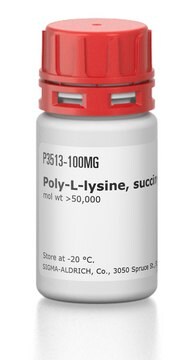P4707
Poly-ʟ-Lysine Hydrobromide
synthetic, liquid, 0.01%, suitable for cell culture
Synonym(s):
PLL Solution
About This Item
Recommended Products
product name
Poly-L-lysine solution, 0.01%, sterile-filtered, BioReagent, suitable for cell culture
sterility
sterile-filtered
product line
BioReagent
form
liquid
mol wt
70—150 kDa
packaging
pkg of 50 mL
concentration
0.01%
technique(s)
cell culture | mammalian: suitable
surface coverage
4 μg/cm2
impurities
endotoxin, tested
solubility
water: soluble
shipped in
ambient
storage temp.
2-8°C
InChI
1S/C18H38N6O4/c19-10-4-1-7-13(22)16(25)23-14(8-2-5-11-20)17(26)24-15(18(27)28)9-3-6-12-21/h13-15H,1-12,19-22H2,(H,23,25)(H,24,26)(H,27,28)/t13-,14-,15-/m0/s1
InChI key
WBSCNDJQPKSPII-KKUMJFAQSA-N
Looking for similar products? Visit Product Comparison Guide
General description
Application
- Poly-L-lysine coated glass coverslips have been used for mounting samples for scanning electron microscopy.
- Poly-L-lysine coated wells were used for trapping of PC-12 cells on electrodes.
- Poly-L-lysine-coated borosilicate glass slides were used for the seeding of viral vector-transduced cells.
Biochem/physiol Actions
Components
Preparation Note
Storage Class Code
12 - Non Combustible Liquids
WGK
WGK 2
Flash Point(F)
Not applicable
Flash Point(C)
Not applicable
Certificates of Analysis (COA)
Search for Certificates of Analysis (COA) by entering the products Lot/Batch Number. Lot and Batch Numbers can be found on a product’s label following the words ‘Lot’ or ‘Batch’.
Already Own This Product?
Find documentation for the products that you have recently purchased in the Document Library.
Customers Also Viewed
Articles
Poly-Lysine enhances electrostatic interaction between negatively-charged ions of the cell membrane and positively-charged surface ions of attachment factors on the culture surface. When adsorbed to the culture surface, it increases the number of positively-charged sites available for cell binding.
3D cell culture overview. Learn about 2D vs 3D cell culture, advantages of 3D cell culture, and techniques available to develop 3D cell models
Cancer stem cell media, spheroid plates and cancer stem cell markers to culture and characterize CSC populations.
Protocols
Poly-L-Lysine Cell Attachment Protocol
Our team of scientists has experience in all areas of research including Life Science, Material Science, Chemical Synthesis, Chromatography, Analytical and many others.
Contact Technical Service





